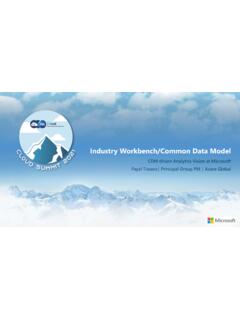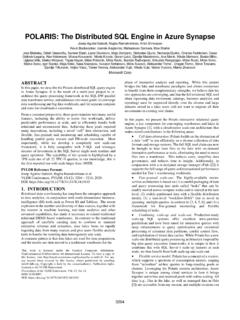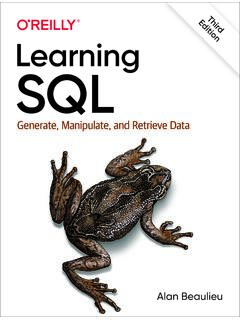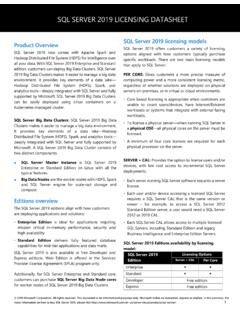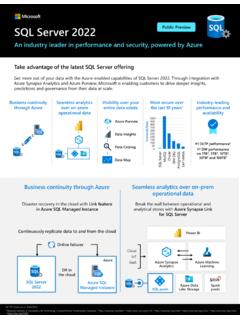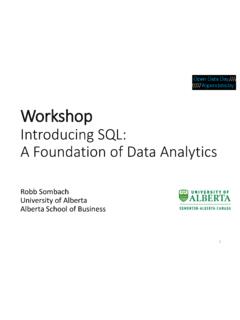Transcription of Apache Spark - Tutorialspoint
1 Apache Spark About the Tutorial Apache Spark is a lightning-fast cluster computing designed for fast computation. It was built on top of Hadoop MapReduce and it extends the MapReduce model to efficiently use more types of computations which includes Interactive Queries and Stream Processing. This is a brief tutorial that explains the basics of Spark Core programming. Audience This tutorial has been prepared for professionals aspiring to learn the basics of Big Data Analytics using Spark Framework and become a Spark Developer. In addition, it would be useful for Analytics Professionals and ETL developers as well. Prerequisite Before you start proceeding with this tutorial, we assume that you have prior exposure to Scala programming, database concepts, and any of the Linux operating system flavors. Copyright & Disclaimer Copyright 2015 by Tutorials Point (I) Pvt. Ltd. All the content and graphics published in this e-book are the property of Tutorials Point (I) Pvt.
2 Ltd. The user of this e-book is prohibited to reuse, retain, copy, distribute or republish any contents or a part of contents of this e-book in any manner without written consent of the publisher. We strive to update the contents of our website and tutorials as timely and as precisely as possible, however, the contents may contain inaccuracies or errors. Tutorials Point (I). Pvt. Ltd. provides no guarantee regarding the accuracy, timeliness or completeness of our website or its contents including this tutorial. If you discover any errors on our website or in this tutorial, please notify us at i Apache Spark Table of Contents About the Tutorial .. i Audience .. i i Copyright & i Table of Contents .. ii 1. Spark INTRODUCTION .. 1. Apache Spark .. 1. Evolution of Apache Spark .. 1. Features of Apache Spark .. 1. Spark Built on Hadoop .. 2. Components of Spark .. 3. 2. Spark RDD .. 4. Resilient Distributed Datasets.
3 4. Data Sharing is Slow in MapReduce .. 4. Iterative Operations on MapReduce .. 4. Interactive Operations on MapReduce .. 5. Data Sharing using Spark RDD .. 6. Iterative Operations on Spark 6. Interactive Operations on Spark RDD .. 6. 3. Spark INSTALLATION .. 8. Step 1: Verifying Java 8. Step 2: Verifying Scala installation .. 8. Step 3: Downloading Scala .. 8. Step 4: Installing Scala .. 9. Step 5: Downloading Apache Spark .. 9. ii Apache Spark Step 6: Installing Spark .. 10. Step 7: Verifying the Spark Installation .. 10. 4. Spark CORE 12. Spark Shell .. 12. RDD .. 12. Transformations .. 12. Actions .. 16. Programming with RDD .. 17. UN Persist the Storage .. 21. 5. Spark DEPLOYMENT .. 23. Spark -submit Syntax .. 27. 6. ADVANCED Spark PROGRAMMING .. 30. Broadcast 30. Accumulators .. 30. Numeric RDD Operations .. 31. iii 1. Spark INTRODUCTION Apache Spark Industries are using Hadoop extensively to analyze their data sets.
4 The reason is that Hadoop framework is based on a simple programming model (MapReduce) and it enables a computing solution that is scalable, flexible, fault-tolerant and cost effective. Here, the main concern is to maintain speed in processing large datasets in terms of waiting time between queries and waiting time to run the program. Spark was introduced by Apache Software Foundation for speeding up the Hadoop computational computing software process. As against a common belief, Spark is not a modified version of Hadoop and is not, really, dependent on Hadoop because it has its own cluster management. Hadoop is just one of the ways to implement Spark . Spark uses Hadoop in two ways one is storage and second is processing. Since Spark has its own cluster management computation, it uses Hadoop for storage purpose only. Apache Spark Apache Spark is a lightning-fast cluster computing technology, designed for fast computation.
5 It is based on Hadoop MapReduce and it extends the MapReduce model to efficiently use it for more types of computations, which includes interactive queries and stream processing. The main feature of Spark is its in-memory cluster computing that increases the processing speed of an application. Spark is designed to cover a wide range of workloads such as batch applications, iterative algorithms, interactive queries and streaming. Apart from supporting all these workload in a respective system, it reduces the management burden of maintaining separate tools. Evolution of Apache Spark Spark is one of Hadoop's sub project developed in 2009 in UC Berkeley's AMPLab by Matei Zaharia. It was Open Sourced in 2010 under a BSD license. It was donated to Apache software foundation in 2013, and now Apache Spark has become a top level Apache project from Feb-2014. Features of Apache Spark Apache Spark has following features.
6 Speed: Spark helps to run an application in Hadoop cluster, up to 100 times faster in memory, and 10 times faster when running on disk. This is possible by reducing number of read/write operations to disk. It stores the intermediate processing data in memory. 1. Apache Spark Supports multiple languages: Spark provides built-in APIs in Java, Scala, or Python. Therefore, you can write applications in different languages. Spark comes up with 80 high-level operators for interactive querying. Advanced Analytics: Spark not only supports Map' and reduce'. It also supports SQL queries, Streaming data, Machine learning (ML), and Graph algorithms. Spark Built on Hadoop The following diagram shows three ways of how Spark can be built with Hadoop components. There are three ways of Spark deployment as explained below. Standalone: Spark Standalone deployment means Spark occupies the place on top of HDFS(Hadoop Distributed File System) and space is allocated for HDFS, explicitly.
7 Here, Spark and MapReduce will run side by side to cover all Spark jobs on cluster. Hadoop Yarn: Hadoop Yarn deployment means, simply, Spark runs on Yarn without any pre-installation or root access required. It helps to integrate Spark into Hadoop ecosystem or Hadoop stack. It allows other components to run on top of stack. Spark in MapReduce (SIMR): Spark in MapReduce is used to launch Spark job in addition to standalone deployment. With SIMR, user can start Spark and uses its shell without any administrative access. 2. Apache Spark Components of Spark The following illustration depicts the different components of Spark . Apache Spark Core Spark Core is the underlying general execution engine for Spark platform that all other functionality is built upon. It provides In-Memory computing and referencing datasets in external storage systems. Spark SQL. Spark SQL is a component on top of Spark Core that introduces a new data abstraction called SchemaRDD, which provides support for structured and semi-structured data.
8 Spark Streaming Spark Streaming leverages Spark Core's fast scheduling capability to perform streaming analytics. It ingests data in mini-batches and performs RDD (Resilient Distributed Datasets) transformations on those mini-batches of data. MLlib (Machine Learning Library). MLlib is a distributed machine learning framework above Spark because of the distributed memory-based Spark architecture. It is, according to benchmarks, done by the MLlib developers against the Alternating Least Squares (ALS) implementations. Spark MLlib is nine times as fast as the Hadoop disk-based version of Apache Mahout (before Mahout gained a Spark interface). GraphX. GraphX is a distributed graph-processing framework on top of Spark . It provides an API. for expressing graph computation that can model the user-defined graphs by using Pregel abstraction API. It also provides an optimized runtime for this abstraction. 3. 2. Spark RDD Apache Spark Resilient Distributed Datasets Resilient Distributed Datasets (RDD) is a fundamental data structure of Spark .
9 It is an immutable distributed collection of objects. Each dataset in RDD is divided into logical partitions, which may be computed on different nodes of the cluster. RDDs can contain any type of Python, Java, or Scala objects, including user-defined classes. Formally, an RDD is a read-only, partitioned collection of records. RDDs can be created through deterministic operations on either data on stable storage or other RDDs. RDD is a fault-tolerant collection of elements that can be operated on in parallel. There are two ways to create RDDs: parallelizing an existing collection in your driver program, or referencing a dataset in an external storage system, such as a shared file system, HDFS, HBase, or any data source offering a Hadoop Input Format. Spark makes use of the concept of RDD to achieve faster and efficient MapReduce operations. Let us first discuss how MapReduce operations take place and why they are not so efficient.
10 Data Sharing is Slow in MapReduce MapReduce is widely adopted for processing and generating large datasets with a parallel, distributed algorithm on a cluster. It allows users to write parallel computations, using a set of high-level operators, without having to worry about work distribution and fault tolerance. Unfortunately, in most current frameworks, the only way to reuse data between computations (Ex: between two MapReduce jobs) is to write it to an external stable storage system (Ex: HDFS). Although this framework provides numerous abstractions for accessing a cluster's computational resources, users still want more. Both Iterative and Interactive applications require faster data sharing across parallel jobs. Data sharing is slow in MapReduce due to replication, serialization, and disk IO. Regarding storage system, most of the Hadoop applications, they spend more than 90% of the time doing HDFS read-write operations.











